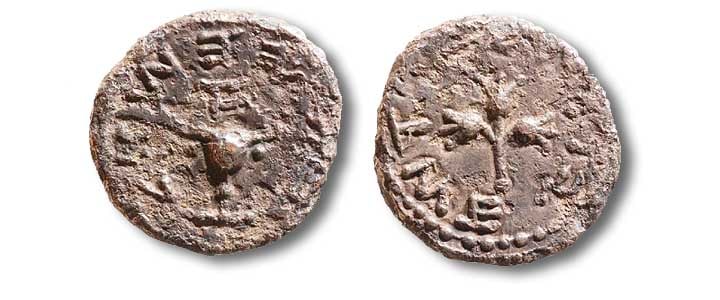A rare and ancient coin used for Holy Temple purposes was discovered by chance in the Jewish town of Neve Tzuf – further evidence of the Jewish historical claim to Jerusalem, Judea and Samaria.
A nine-year-old girl from a town in Samaria found a historical treasure last May on her way home from school – a rare and ancient half-shekel coin with the inscription “Holy Jerusalem.”
Hallel Halevy of Halamish (Neve Tzuf), speaking to Times of Israel, said that she googled “ancient treasures” when she got home, came up with what seemed like a match and kept it in a box with some jewelry and other “childhood treasures.”
Last week, her 11-year-old sister saw the coin. Realizing it could be a significant piece of history, she showed it to their father, lawyer Shimon Halevy, who then brought it to Bar-Ilan University Prof. Zohar Amar, a local resident and a historian of ancient Land of Israel flora and fauna.
“Amar had actually written an essay on the wine presses in the nearby archaeological site, Chubalta, near which the coin was found. Amar was intrigued by what he saw and asked Shimon to bring the coin to his house so he and his wife, Tamar, who is also knowledgeable on such subjects, could study it,” Times of Israel explained.
“At first glance, the Amar couple thought it was a rare full shekel coin, minted by Jews during the Great Jewish Revolt against the Romans prior to the destruction of the Second Temple,” the Times continued.
After further research, they concluded it was a half-shekel coin – the type every male 20 years of age and over was required to pay in taxes to the Holy Temple in Jerusalem, according to the biblical commandment in the Book of Exodus (30:13–15).
Jewish Life in Ancient Israel
“Amar believes the coin was minted during the Great Jewish Revolt sometime during the years 66-70 CE. More precisely dating it may be tricky, however, because only one side is clearly legible. The other could have been un-minted, or was rubbed off with age. On the visible side is an image of a three-pronged pomegranate, around which is written ‘Holy Jerusalem’ in First Temple Hebrew lettering,” the Times reported.
Speaking to Arutz-7, Amar noted that “such coins were found in Israel, but the discovery at Neve Tzuf raises interest because the area was a very large center and, according to [historian] Josephus, Jews participated during the revolt and there is evidence that supports this report. This is an area where the pilgrims passed through on their way to Jerusalem. The Romans understood that if they wanted to conquer Jerusalem they should first oppress the Jews here on the way to Jerusalem. Also found in the area are communal mikvaot (ritual pools) for those interested in going up to Jerusalem in purity.”
The village of Beit Rima, which appears in the Talmud, is located three kilometers away and from there the libations were brought to the Temple, Amar said. “In the area of Neve Tzuf, there is a unique site in the world where a special wine was produced, which in case of great need was permitted to be transferred to the Temple. There is a great deal of data linking the Neve Tzuf area to the subject of the Temple and the coin sheds additional light on this issue.”
Countering Palestinian Lies
This find is yet another piece of evidence of the Jewish People’s ancient ties to the Land of Israel – including, of course, Jerusalem, Judea and Samaria, the biblical heartland – demonstrating the fallacy of the claim by enemies of the Jewish State that Palestinian Arabs are the descendants of the inhabitants of ancient Israel.
Although the discovery is rare, this was not the first time an ancient half-shekel coin was discovered in modern-day Israel. In 2008, for example, the Temple Institute in Jerusalem announced a “Chanukah miracle” when a 14-year-old volunteer found one at the Temple Mount rubble archaeological site, formed 10 years earlier in order to recover buried remnants at the holy site.
“After all that we went through recently,” Amar told Arutz-7, in an apparent reference to the slaughter of three members of the Salomon family in July, as well as other Palestinian terror attacks, “the discovery is very interesting because the Romans wanted to kill us, but we came back here, and this year we will be celebrating the 40th anniversary of the settlement of Neve Tzuf.”
By: United with Israel Staff
